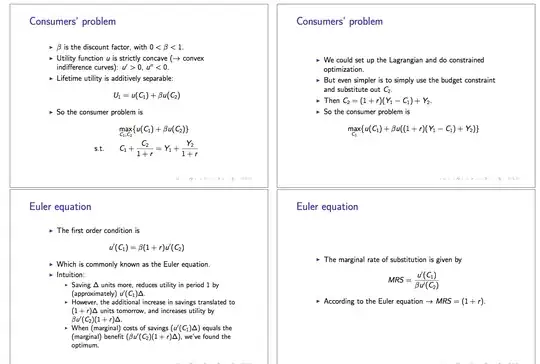The OP's confusion comes from the fact that he or she does not apply the chain rule correctly and interprets the Euler condition
$u'(c_1) = \beta (1+r) u'(c_2)$
as
$ u_{C_1}(C_1) = \beta(1+r) u_{\boldsymbol{C_1}}(C_2) $
This is not the correct way to read the Euler condition and one should really read
$ u_{C_1}(C_1) = \beta(1+r) u_{\boldsymbol{C_2}}(C_2) $
Any doubt can be cleared by rederiving the FOC. The maximisation problem is
$\max_{C_1,C_2} u(C_1) + \beta u(C_2) \qquad s.t. \qquad $
\begin{equation*}
C_1 + \frac{C_2}{1+r} = Y_1 + \frac{Y_2}{1+r} \implies C_2 = {-C_1}({1+r}) + Y_1(1+r) + {Y_2}
\end{equation*}
So substituting the constraint, the problem can be written as
\begin{align}\max_{C_1} u\Big(C_1\Big) + \beta u\Big(\underbrace{{-C_1}({1+r}) + Y_1(1+r) + {Y_2}}_{=C_2}\Big)\end{align}
To find the FOC, one needs to apply the chain rule to the second period's utility function. Applying the chain rule carefully we have
\begin{align} \frac{\partial \beta u(C_2)}{\partial C_1} = \beta \frac{\partial u(C_2)}{\partial C_2} \frac{\partial C_2}{\partial C_1}\end{align}
In our case that is
\begin{align} \frac{\partial \beta u(C_2)}{\partial C_1} = \beta \frac{\partial u(C_2)}{\partial C_2} (-1)(1+r)\end{align}
Or to put it in yet another way
\begin{align}\frac{\partial \beta u(C_2)}{\partial C_1} & = \frac{\partial \big[\beta u\big({-C_1}({1+r}) + Y_1(1+r) + {Y_2}\big)\big]}{\partial C_1}\\ & = \beta \frac{\partial \big[\ u\big({-C_1}({1+r}) + Y_1(1+r) + {Y_2}\big)\big]}{\partial \big({-C_1}({1+r}) + Y_1(1+r) + {Y_2}\big)} \frac{\partial \big({-C_1}({1+r}) + Y_1(1+r) + {Y_2}\big)}{\partial C_1} \\ & = \beta \frac{\partial \big[\ u\big({-C_1}({1+r}) + Y_1(1+r) + {Y_2}\big)\big]}{\partial \big({-C_1}({1+r}) + Y_1(1+r) + {Y_2}\big)} (-1) (1+r) \\ &= \beta \frac{\partial u(C_2)}{\partial C_2} (-1)(1+r) \end{align}
Then, by definition, given a utility function $U(c_1,c_2)$, the MRS of good one with respect to good two is
$MRS := \frac{{\partial U}/{\partial c_1}}{{\partial U}/{\partial c_2}}$
In your case, as stated in your notes, you get
$MRS = \frac{{\partial u}/{\partial c_1}}{\beta{\partial u}/{\partial c_2}} = \frac{u'(c_1)}{\beta{u'(c_2)}}$
At an equilibrium, when consumers maximize utility, the Euler condition must be satisfied, that is
$u'(c_1) = \beta (1+r) u'(c_2)$
So replace this specific value for $u'(c_1)$ in the formula for the MRS and you get
$MRS = \frac{u'(c_1)}{\beta{u'(c_2)}} = \frac{\beta (1+r) u'(c_2)}{\beta{u'(c_2)}} = (1+r)$.
As a good exercise, try to convince yourself that if the MRS takes another value, then the consumer can benefit from reallocating resources between the first and the second period.
